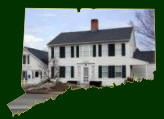|
In grateful
appreciation to:
Bob Grigg
Curator:
Colebrook Historical
Society
Municipal Historian:
Town of Colebrook,
County of Litchfield,
State of Connecticut, USA

 |
There were no major town officers other
than Townsmen (selectmen), Constable, Clerk and special committees, but
there were several lesser ones. Two of the most active groups of officers
were the surveyors of highways and fence viewers. Surveyors were responsible
for maintaining existing roads and building new ones when needed. Fence
viewers maintained fences along the common lands, observed and brought to
order those who neglected animals there, and noted whose animals got loose
from private land and caused damage to others’ lands.
Packers and Sealers were men who inspected
certain goods in town, usually barrels of pork and beef and tanned hides,
then stamped them to show that the goods conformed to existing colonial
standards. The sealer of weights and measures inspected and certified all
the scales used in business transactions.
Windsor, in 1641, established the office of
Hayward, who inspected all grains that were sold and certified them to be of
acceptable quality. Thirty-one years after Windsor elected its first
Hayward, the Connecticut General Assembly ordered all towns in the colony to
do the same (1672).
When New Haven was forced by imperial fiat in
1662 to join the Connecticut Colony, they tried to protect and perpetuate
its magisterial form of town government. As part of its terms for
submitting, New Haven asked to be constituted into a separate county within
the larger colony. Connecticut agreed to this, and in 1666, the county
system was created.
At this time, the General Assembly created
four counties, i.e. Fairfield, Hartford, New Haven and New London,
each of which was presided over by a county court. In 1667, the General
Court ordered each county court to appoint a “grand jury of 12 men at least”
from amongst the towns.
The General Court added to the juryman’s
duties so that by 1710, he effectively became a social constable in his
town. He assisted the selectmen and constables in maintaining order and
assuring high standards of moral conduct.
This period from 1667 – 1712 was the time when
many people in Massachusetts and Connecticut were rebelling against the
strict Puritan codes of behavior. In 1679 Massachusetts created the office
of Tithingman in each town to combat this moral decay. Grand jurymen were
the Connecticut General Courts’ solution to this problem. The major
differences between the two states concerning these offices was that the
tithingman in Massachusetts was an elected official, while the Connecticut
grand juror was appointed by the county court. In 1712 Connecticut’s General
Assembly ordered all towns to elect at least two grand jurymen a year.
Tithingmen had long existed as parish
functionaries in East Anglia and other parts of England; the colonial
governments adopted the office to suit their needs.
The Connecticut office of Tithingman, borrowed
from Massachusetts, was created by the General Assembly in 1721 to combat
moral laxity. Colebrook’s first town meeting, held on December 13, 1779,
created the office of Grand Jury. It was not until the town meeting of
December 10, 1781 that the office of tything [sic.] man was
established. The office was maintained in Colebrook through the year 1865,
but was not voted upon at the town meeting of October1, 1866.
The office of “Lister”, as it applied to
Colebrook, evolved from the title “Ratemaker”, which in turn changed to
“Lister and Rater”. In 1779 Colebrook elected three listers to set the tax
rates.
The following is a list of officers
established at Colebrook’s first town meeting in 1779:
A
Moderator
Registor, or Town Clerk
3
Selectmen
Town Treasurer
Constable
1
Grand Jury
3
Surveyors of Highways
3
Listers
Collector
Brander of Horses
Sealer of Measures
Sealer of Leather
Colebrook Historical Society
- Bob Grigg
View/Print PDF
- Back to
Index -
|
|